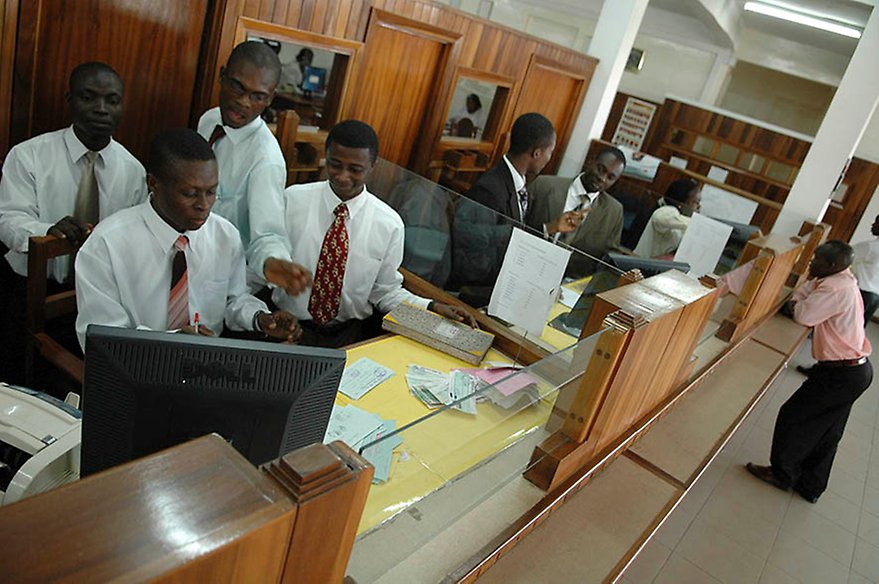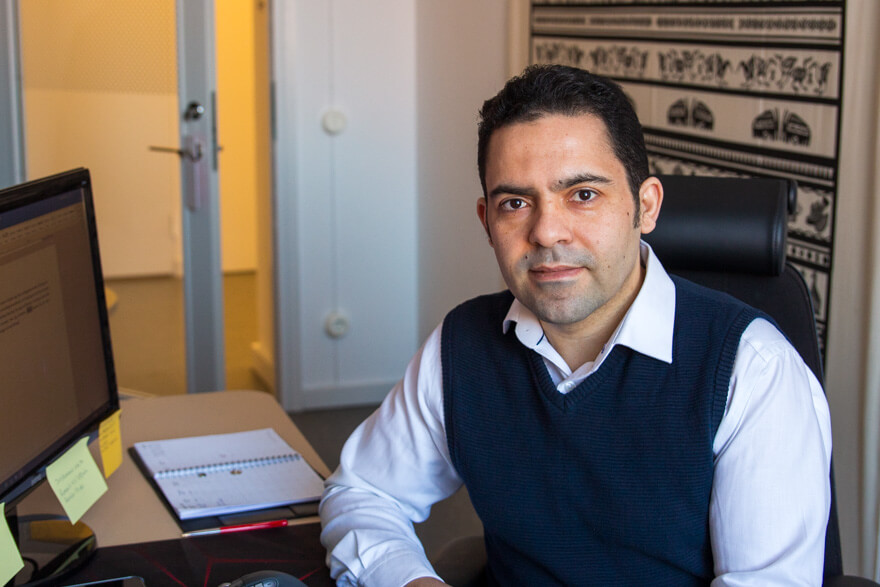Africa is not a country – especially when it comes to debt

Ghana’s public debt stood at over $46.7 billion by the end of September 2022, of which 42 percent was domestic debt. In December, it announced it would suspend payments on external debt, effectively defaulting. Photo from the Akuapem Rural Bank Ltd., founded in 1980, in the town of Mamfe, Ghana. Photo: Jonathan Ernst / World Bank
After sustaining the consecutive blows of the covid-19 pandemic and the effects of Russia’s invasion of Ukraine, several already vulnerable African nations find themselves in debt distress. A creditor composition more diverse than prior decades may make it more difficult for African nations to get back on even keel again, according to NAI researchers.
On 19 January, the African development bank (AfDB) released a report titled ‘Africa’s Macroeconomic Performance and Outlook’ which projects that “Growth across all five African regions was positive in 2022 and the outlook for 2023–24 is projected to be stable.”
However, the report also indicated that rising sovereign debt across the continent is one of its “biggest challenges”
The report said that 22 African nations are currently in or at risk of debt distress. This is due to a number of factors including the economic shocks of the Covid-19 pandemic and Russia’s invasion of Ukraine.

Assem Abu Hatab. Photo: Mattias Sköld
The challenging situation for many countries was exacerbated by monetary-policy tightening by the US Federal Reserve, which strengthened the dollar. This coupled with the depreciation of African currencies due to inflation and the fall in commodity prices makes it costlier to pay back loans. “This also effectively locks out African countries from the global capital market” says NAI senior researcher Assem Abu Hatab.
This affects middle income countries like Egypt and Ghana the most as unlike lower income nations they don’t have the same access to grants, forcing them to recourse to loans.
“Africa has a big infrastructure gap, and borrowing is important to finance investment. Accumulation of debt is part of African countries development strategies, but the strategies need to be sustainable, with an emphasis on high and sustainable growth, moderate interest rates and prudent fiscal policies.” explains Jörgen Levin, senior researcher at NAI.
Debt is arguably a normal part of any country’s growth but the problem for many African nations is not the debts themselves but the high interest rate on them.
“The interest rate on private lender loans is between 7 and 11 percent because Africa is perceived as a high risk but high return market” says Abu Hatab. Countries like the US can borrow with an interest rate of one percent as their markets are stable and it is considered a safe investment.
Some have decried that there is a double standard between African countries and other developing nations. "When you look at the risk premium put on African countries you just question, why," Ken Ofori-Atta, Ghana's finance minister said in an interview with Bloomberg in 2020 "There is no basis for us borrowing at 6 percent, 7 percent, or 8 percent while other countries borrow at cheaper rates.”

Jörgen Levin. Photo: Mattias Sköld
Levin notes that this situation is similar to the debt crisis of the 1980’s and 1990’s but with the added complication that much more of African debt is owed to private foreign investors and China.
“This makes debt restructuring more difficult than it was back in the 90’s and early 2000’s when debt was mostly to institutions like the IMF and the World Bank, and donors like SIDA could funnel money through them to clear part of that debt. Now, with other lenders such as China and private investors, bilateral donors are not likely to pay off debt”, says Levin, and continues:
But while there seem to be difficult times ahead for these countries as they seek to restructure their debt, that doesn’t automatically translate into a unified narrative of “bad African debt”.
Despite this need for restructuring, only four governments – Chad, Ethiopia, Zambia and Ghana – have sought debt restructuring under the G20’s new Common Framework, evidence that many can cope with current debt levels.
The G20 mechanism consists of the Paris Club of high-income countries coming together with China to try to restructure the debts of low-income countries.
In 2023 a number of other African countries are also expected to grow their economies by more than 5 per cent in the same period. Those include Rwanda at 7.9 per cent, Democratic Republic of Congo at 6.8 per cent Senegal at 9.4 per cent, and Niger at 9.6 per cent. With positive performance indicators across the continent.
TEXTS: Heba Habib
We have looked at two African countries, to illustrate the difference in impact.
Ghana:
Ghana’s public debt stood at over $46.7 billion by the end of September 2022, of which 42 percent was domestic debt. In December it announced it would suspend payments on external debt, effectively defaulting. Ghana then sought a $3bn debt bailout from the IMF and committed to a programme of debt restructuring.
“IMF loans are important, not because of the sum borrowed itself but because this is a sign for the international market that the country is still worth investing in” explains Abu Hatab
The restructuring process is also important as completely defaulting without payment means the country would run a further risk of “being punished by the market” says Levin, losing future investment and loan opportunities critical to its economic recovery.
Of Ghana’s external debt which includes principal (the actual loan amount without interest) and interest amounts between 2023 and 2029, 64 percent is to private lenders, 20 percent is to multilateral institutions ,10 percent to China. and 6 percent to other governments.
Approximately $13 billion, 25 percent, of Ghana’s external debt is held in the form of Eurobonds. This is a foreign currency denominated bond issued by governments. These types of bonds have shorter maturity and are costlier than borrowing from institutions like the World Bank.
“Eurobonds and borrowing from the Chinese government are very attractive as it comes with fewer conditions than borrowing from the World Bank and the IMF” says Levin.
This explains the large share of external debt to private lenders despite the high interest rates.
Cote d’Ivoire
Cote d’Ivoire is projected to grow its economy by 6.5 percent in 2023 and has a long history of borrowing from international capital markets, particularly France. In recent years, much like the rest of the continent, it has turned to China for funding of several large infrastructure projects. The country’s debt is sustainable due to the implementation of President Alassane Ouattara’s National Development Plan (the third national development plan since 2012) which focuses on the promotion of business-friendly practices, structural transformation of the economy through prudent investment in vital sectors and improving governance.
“Investment financed by borrowing has a positive impact on economic growth performance” explains Levin.
But financing from other countries has proven insufficient for Cote D’Ivoire’s infrastructure and development agenda, so like many African countries, it has recoursed to Eurobonds which, according to the IMF, represents about half of the country’s total external debt.
There is some risk when the Eurobonds mature (reach the end of their ten- year term) in May 2028 and the country must begin repaying bond holders. Countries often fall into a trap by opting for infrastructure projects that do not prove profitable in a ten-year span.
“In these cases, African nations can opt to restructure their debt, get the help of the IMF to pay off the Eurobond interest” observes Levin.
“But with good governance, transparency and boundaries on how to spend the money, an unsustainable situation can be avoided.”
